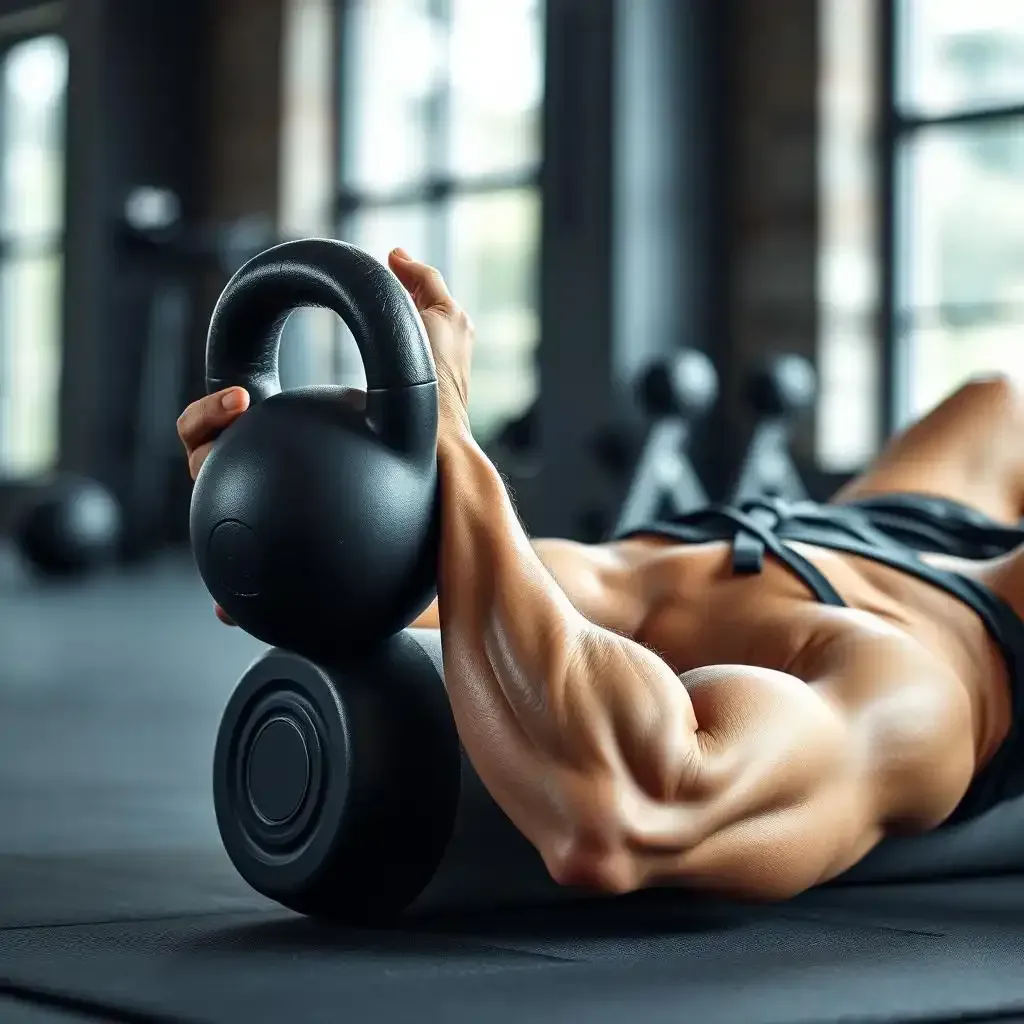Table of Contents
Ever felt those knots in your muscles after a killer kettlebell workout? Yeah, me too. That's where kettlebell foam rolling comes in – it's like a secret weapon for your muscles. It's not just about relaxing; it's about getting the most out of your kettlebell sessions. This article will guide you through the amazing world of kettlebell foam rolling, from beginner-friendly moves to advanced techniques that will leave you feeling stronger and more flexible. We'll explore how combining these two fitness powerhouses can boost your workouts and help you avoid those pesky injuries. Get ready to learn how kettlebell foam rolling can transform your fitness progression! Check out our other kettlebell guides at kettlebellworkout.homes for even more tips and tricks to help you crush your fitness goals. Let's examine in!
Getting Started with Kettlebell Foam Rolling: A Beginner's Guide

Getting Started With Kettlebell Foam Rolling A Beginners Guide
Okay, so you're thinking about adding kettlebell foam rolling to your routine, huh? Smart move! Think of it like this: your muscles are like a really, really good chocolate cake after a tough kettlebell workout – delicious, but maybe a little stiff and needing some TLC. Foam rolling is the perfect spatula to smooth things out. It's not scary, I promise. It's all about gently easing out those knots and kinks that build up from all that amazing kettlebell action. You'll feel way better, and your swings will thank you.
First things first: get yourself a foam roller. Don't go crazy; a basic one from a sporting goods store is just fine. You also need your kettlebells, of course. Now, I'm not saying you need to foam roll *every* single muscle, but focusing on the major players – your back, shoulders, and legs – is a great start. Start slow. Don't just jump on and mash yourself. Find those tight spots, and gently roll over them. It might feel a little tender at first – that's totally normal. Think of it as a massage, but with less fancy oils and more self-reliance. It’s like giving your muscles a little reset button. For more help getting started with kettlebells, check out our kettlebell basics guide.
Body Part | Foam Rolling Technique | How it Helps |
|---|---|---|
Back | Roll lengthwise, focusing on the spine | Relieves tension, improves posture |
Shoulders | Roll in circles, applying pressure to tight areas | Increases mobility, reduces stiffness |
Legs | Roll from hip to ankle, focusing on quads and hamstrings | Increases blood flow, reduces soreness |
Remember, you don’t have to be a pro to get started! Just a few minutes of foam rolling before and after your kettlebell workout can make a world of difference. You’ll feel more relaxed, more mobile, and maybe even less sore. Plus, you'll likely prevent injuries too. If you're a beginner with kettlebells, we have some great resources for you on our site. Check out our beginner kettlebell workout page.
Before you start, listen to your body. If something hurts, stop. Don't push through pain. And remember, consistency is key. Even a few minutes of foam rolling each day can help. If you're struggling with your form, check out our kettlebell form guide for some extra tips. This is your body, so treat it well!
- Find a quiet space to roll.
- Start slowly and gently.
- Listen to your body!
I know it might seem simple, but trust me, consistent foam rolling can help you avoid injuries and improve your form. Think of it as preventative maintenance for your awesome kettlebell muscles! Want to learn more about kettlebell safety? Check out our page on kettlebell safety tips.
Kettlebell Foam Rolling Exercises: Targeting Specific Muscle Groups
Focusing on Your Back
Okay, let's talk backs. After a serious kettlebell session, my back often feels like it's been tied in knots by a mischievous goblin. Foam rolling helps me untangle that mess. Lie on your roller, placing it just below your shoulder blades. Slowly roll up and down, focusing on any particularly tense spots. Don't rush; find those tight spots and give them some gentle attention. Think of it as giving your back a mini-massage, but with less lotion and more self-sufficiency. You'll feel amazing after a few minutes, and those kettlebell swings will feel smoother than ever. If you’re new to kettlebells, check out our beginner’s guide for more info; it's a great resource for getting started safely and effectively. For more guidance, check our kettlebell exercises for starters page.
- Find a comfy spot on the floor.
- Place the roller under your back.
- Roll slowly, focusing on tense areas.
Targeting Those Troublesome Shoulders
My shoulders? They're usually the first to complain after a tough kettlebell workout. They're like, "Hey, we carried all those bells! Give us a break!" So, I give them a break – with foam rolling. Sit on the roller, placing it just under one shoulder. Roll gently in small circles, applying pressure to any tight spots. This helps improve shoulder mobility, which is super important for those overhead presses and swings. Remember, proper form is key to preventing injuries, so don't skip this step! To learn more about kettlebell safety and proper form, check out our for some extra help.
Muscle Group | Foam Rolling Technique | Benefits |
|---|---|---|
Back | Roll lengthwise, applying pressure to tight areas | Relieves tension, improves posture |
Shoulders | Roll in circles, focusing on the shoulder blades | Increases mobility, reduces stiffness |
Legs | Roll from hip to ankle, focusing on quads and hamstrings | Increases blood flow, reduces soreness |
Advanced Kettlebell Foam Rolling Techniques for Improved Performance

Advanced Kettlebell Foam Rolling Techniques For Improved Performance
Targeting Deeper Muscle Layers
Okay, so you've mastered the basics of kettlebell foam rolling. You're feeling pretty good, your muscles are thanking you, and your kettlebell swings are smoother than a baby's bottom. But what if I told you there's a whole other level? It's like discovering a secret level in your favorite video game – exciting, right? We're talking about targeting those deeper muscle layers. Instead of just rolling lightly over the surface, try applying more pressure. Think of it like this: imagine you're kneading dough – you're not just gently brushing the surface; you're really getting in there to work it. You'll find those super-tight knots that you didn't even know were there. It might feel intense, but that's a good thing! This is where the real magic happens – increased flexibility, improved range of motion, and a reduction in muscle soreness. Remember, listen to your body; don't push yourself too hard. If you're ever unsure about something, check out our page for some extra help.
- Increase pressure gradually.
- Hold on tight spots for 30 seconds.
- Breathe deeply throughout.
Incorporating Kettlebell Movements
Here’s where things get really interesting. Why just roll when you can roll *and* kettlebell at the same time? It's like combining two awesome things into one super awesome thing. For example, try doing a goblet squat while sitting on your foam roller. This adds an element of instability, which really challenges your core and improves your balance. Or, how about this: try a kettlebell row while holding your roller against your back. This helps to target your back muscles more effectively. This isn't just about the foam rolling itself; it's about using it as a tool to enhance your kettlebell workouts and push your limits further. It’s like adding a turbocharger to your kettlebell routine. Don't be afraid to experiment and find what works best for you. For more ideas on how to improve your kettlebell workouts, you can check out our kettlebell workout tips page. It’s full of great advice!
Exercise | Foam Roller Placement | Benefits |
|---|---|---|
Goblet Squat | Underneath your glutes | Improved balance, core engagement |
Kettlebell Row | Against your back | Increased back muscle activation |
Troubleshooting Common Kettlebell Foam Rolling Mistakes
Ignoring Your Body's Signals
Okay, let's be real: foam rolling can be intense. It's not supposed to be a walk in the park, but it shouldn't feel like a medieval torture session either! If something hurts – I mean *really* hurts, not just a little "ouch" – stop. Seriously. Don't push through pain. That's a recipe for injury, and nobody wants that. Think of your body as a finely tuned sports car – you wouldn't drive it if it was making weird noises, would you? Same goes for foam rolling. Listen to your body; it's trying to tell you something. If you're unsure about anything, it's always best to check with a physical therapist or doctor. They can help you identify what's going on and guide you on how to proceed. Remember, preventing injuries is way easier than fixing them later! For more info on preventing injuries, check out our kettlebell injury prevention guide.
- Pain is not gain (unless you're a masochist).
- Stop if something feels seriously wrong.
- Consult a pro if needed.
Rolling Too Fast and Too Hard
I get it; you're eager to get those knots out. You're ready to release your inner massage therapist, but hold your horses! You don't need to attack your muscles like a rabid badger. Slow and steady wins the race, my friend. Focus on finding those tight spots and gently rolling over them. Apply enough pressure to feel the tension release, but don't go overboard. Think of it like kneading bread – you want to work the dough gently, not smash it. Rushing through the process isn't only less effective, it also increases your risk of injury. Give your muscles time to adjust and relax. Remember, foam rolling is a marathon, not a sprint. If you’re still unsure about how to use a foam roller correctly, you might find our helpful. It has some great tips on proper form and technique.
Mistake | Solution |
|---|---|
Rolling too fast | Slow down, focus on the movement |
Rolling too hard | Apply gentle, consistent pressure |
Ignoring tight spots | Focus on areas of tension, hold for 30 seconds |
Final Thought
So, there you have it – kettlebell foam rolling isn't just some trendy fitness fad; it's a powerful tool for enhancing your kettlebell workouts and overall fitness. By incorporating these techniques into your routine, you can improve your performance, reduce your risk of injury, and reveal a new level of strength and flexibility. Remember, consistency is key, so start small, listen to your body, and enjoy the process toward a fitter, stronger you. Happy rolling!